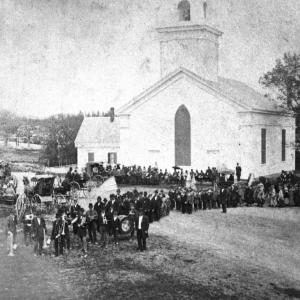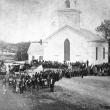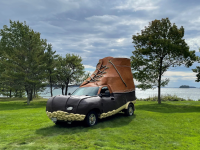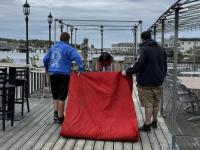Charley McCobb-Civil War Soldier, part III
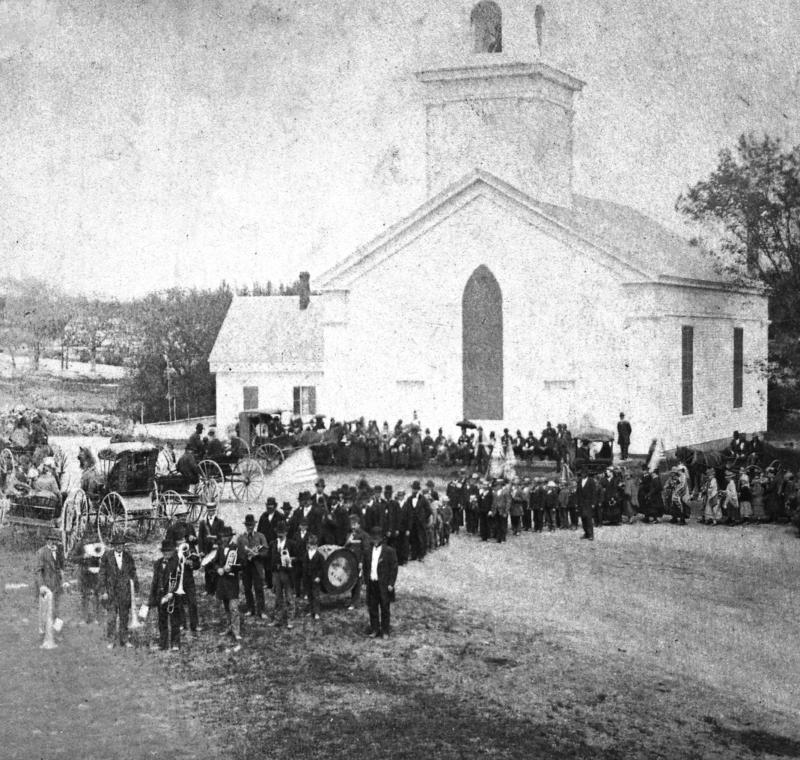 The 1848 Congregational Church on Townsend Avenue, as it appeared in 1880. Built by blacksmith-shipbuilder-hotel owner John Weymouth, the original roof was not as sharp as the present one, which was added in 1881. Having been in the upper part of the church, I know the older, massive, skeletal roof timbers are still in place. The 1880 crowd is on hand for Memorial Day. No doubt Charley's funeral 17 years earlier brought out a crowd many times the size of the 1880 one. Courtesy of the Boothbay Region Historical Society
The 1848 Congregational Church on Townsend Avenue, as it appeared in 1880. Built by blacksmith-shipbuilder-hotel owner John Weymouth, the original roof was not as sharp as the present one, which was added in 1881. Having been in the upper part of the church, I know the older, massive, skeletal roof timbers are still in place. The 1880 crowd is on hand for Memorial Day. No doubt Charley's funeral 17 years earlier brought out a crowd many times the size of the 1880 one. Courtesy of the Boothbay Region Historical Society
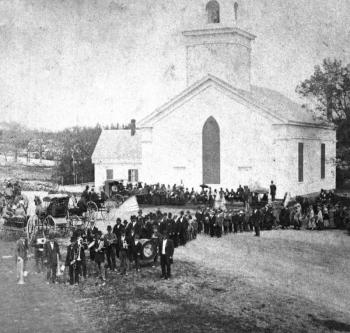 The 1848 Congregational Church on Townsend Avenue, as it appeared in 1880. Built by blacksmith-shipbuilder-hotel owner John Weymouth, the original roof was not as sharp as the present one, which was added in 1881. Having been in the upper part of the church, I know the older, massive, skeletal roof timbers are still in place. The 1880 crowd is on hand for Memorial Day. No doubt Charley's funeral 17 years earlier brought out a crowd many times the size of the 1880 one. Courtesy of the Boothbay Region Historical Society
The 1848 Congregational Church on Townsend Avenue, as it appeared in 1880. Built by blacksmith-shipbuilder-hotel owner John Weymouth, the original roof was not as sharp as the present one, which was added in 1881. Having been in the upper part of the church, I know the older, massive, skeletal roof timbers are still in place. The 1880 crowd is on hand for Memorial Day. No doubt Charley's funeral 17 years earlier brought out a crowd many times the size of the 1880 one. Courtesy of the Boothbay Region Historical Society
Boothbay Civil War soldier Charley McCobb, who joined Company E of the 4th Maine Regiment in June 1861, had served more than two years when he took part in the battle of Gettysburg, his last act. The bewildering number of differing accounts of his death point up the difficulty of nailing down good, solid historical information. One surviving account of an event can greatly simplify things, but relying on it as gospel is risky.
Local accounts of Charley's death at Gettysburg came from fellow Boothbay soldiers near him in battle: Jason Carlisle, one of seven men who signed up with Charley, and Dr. Alden Blossom. Alden, a well-beloved mid-to-late 1800s Boothbay doctor, was an Army surgeon in another regiment. His house, formerly on Oak Street across from the present museum, was torn down for the bank parking lot.
Charley's death at Gettysburg
Charley's 4th regiment was near the Devil's Den at Gettysburg on the afternoon of July 2, 1863. According to the 1892 Boston Globe's version, probably provided by Jason Carlisle, "It was in the heat of the battle on the afternoon of the second day of the fight that McCob fell. He was picked up by Captain Carlisle and others of Company E and borne from the field to the camp hospital where he died in a short time. He begged them to leave him where he fell and look for those who needed care."
Rev. William Leavitt, 1860s minister of the Congo Church in present-day Boothbay Harbor, wrote to the Register from Nebraska in 1892 to correct the Globe's inaccuracies about Charley's death. "The regiment was lying low, but wishing to know what the enemy was doing, he stepped up on a rock and fell by a ball from a rebel sharpshooter's rifle." Leavitt went on, "According to my recollection, he lingered for a day or two being tenderly cared for in one of the homes in Gettysburg and dying July 4th."
Multiplying accounts of his death
Bess Reed wrote up Dr. Blossom's memories. "Dr. Alden Blossom, army surgeon, told a rather different account. As assistant to a doctor, Charley had attended to all the wounded brought to him behind the shelter of rocks." The story then duplicates the Globe's, though Bess, in writing that Charley was mortally wounded, may have thought he died right there. In one place she lists July 2 as the day of his death; in another, July 3. Greene's 1906 history lists July 4. One of two places in the Adjustant General's report uses the date July 3; elsewhere it's July 2. My friend and Civil War expert Earl Leavitt explained that reports were sent by men of differing rank in the command structure. I choose to believe the July 2 date.
Material that trustee Susan Leach obtained from Bowdoin College also gave two conflicting dates in letters written to Charley's brother by J. E. Adams and by the chaplain of the 3rd Maine Regiment. Adams claimed he was hit the 3rd and died the next day. The chaplain said he was wounded in the afternoon of July 2 and died in the night. He also revealed that Charley said of his coming death that he was gratified, "in being permitted so soon to solve its mystery and know what lies beyond."
Charley comes home
It was rare for any dead Civil War soldier to be returned to his hometown, but Charley was — maybe. Earl Leavitt said, "Given the thousands of casualties treated and the dead buried, I am astounded that anyone knew exactly where Charley was buried" — another detail that may be in doubt. Charley's brother Abial traveled to Gettysburg and, according to Bess, found the woman who had nursed him for two days. She showed Abial where he was buried, so Abial was able to bring Charley back to Boothbay. Also, J. E. Adams claimed in his letter that he found Charley's grave and informed his brother; the two accounts don't really conflict since both could have occurred.
On August 6, 1863, the day of Charley's funeral at the Congo church, bells tolled and all businesses were closed, with some decked in mourning. J. E. Adams spoke extemporaneously after the minister's funeral address. Eyewitness and local minister Rev. William Leavitt said, "The feeling of seeing the throng was one of wonder why they did not go in." But the inside of the church was "already packed to its uttermost capacity." Other eyewitnesses were equally impressed by the immense multitude, perhaps the largest ever to crowd the church and surroundings. Charley was buried Sept. 25, 1863.
Event Date
Address
United States

